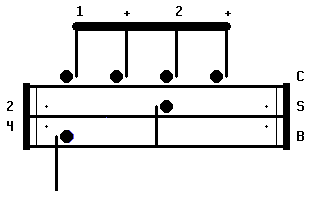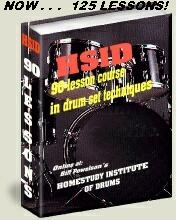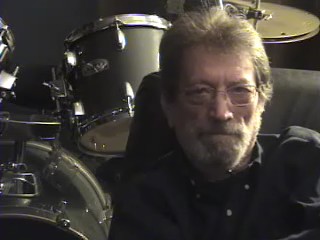WHAT IS A PERMUTATION?
Now I must introduce you to a new word. The word is PERMUTATE, and that is what we are going to do to the poor little rock beat and all the other basic dance beats as well. The dictionary defines the word "PERMUTATE" primarily as:
For drummers, the "set of things" is the way we vary the snare or bass drum against the cymbal rhythm. Simply put, the number of cymbal notes in the measure will tell you precisely how many variation possibilities (permutations) exist per measure in that particular basic dance beat pattern. This means that virtually any measure of any piece of music will contain a specific number of variation possibilities based on the STEADY cymbal note "flow". We may assign each variation possibility a logical number name on a chart that I will explain in a moment. . ARE YOU CONFUSED YET? Just shake your head and continue, it gets easier! Don't worry if math is not your best subject, I have already done all the work. However, if you are interested in learning about the actual math and how it works I have added the formulas at the end of this section.
We will examine the existence 65,536 Rock variations in a moment. Each of these beat possibilities abides theoretically in every measure of any song in the eighth rock category. You will also discover that the concepts learned here will apply to every form of any conceivable time signature. This means that the number of beat possibilities gained from this knowledge is astronomical. We will get to the time signature stuff later!

The important thing is awareness! You are learning the mathematics of rhythm. If you understand the structure, you will be more inclined to innovative discovery as you play!

Computerized drum machines can play most of these patterns but it will take a human mind to do the programming. This information is very important to the drum machine programmer or the aspiring drummer.
Can you read and play this beat?
EIGHTH "ROCK" 2/4:
 If you can read and understand the pattern on the right, the remainder of this study should be easy.
If you can read and understand the pattern on the right, the remainder of this study should be easy.
Please refer to the section,Reading Three lines of Music ,if you are needing help with this beat.
REMEMBER:
- Top line = Cymbal (right hand)
- Center line = Snare (left hand)
- Bottom line = Bass drum (right foot)
Our assignment is to discover all the rhythmic possibilities that are contained in this beat pattern. We may place snares or bass drum notes anywhere and in any order along the line. How many possibilities exist? Think about it for a minute. . .
I will give you a clue but it is important that you study the chart on the next page very carefully.. There are 16 total possibilities and the number is the same for both the Bass and Snare. This is the embryo of a system that will produce more dancebeat variations than you can imagine. Stay with me and I guarantee it will be worth the effort. There are still some things to explain before we get down to business. First of all, we need to set a few guidelines that will insure that the full benefit will be realized from this lesson.
Some of the beat patterns created from the upcoming chart may reverse the polarity or the downbeat/upbeat flow of the music, so I have devised a coding system that should enable you to work with only the beats that will be most useful. The coding is very simple. If you see an "S" above a pattern then that pattern will best function as a snare idea. Likewise, "B" works best as a bass idea. You will also see "S/B" for ideas that may be used for snare or bass. "Inv" indicates an inversion which can be utilized as either a snare or bass example. An inversion is a pattern that is neither on or off the beat, it is actually in between the beats. Inversions can produce some very interesting rhythmic effects but might be best avoided in the beginning because they tend to confuse the downbeat/upbeat flow, without actually reversing it.
With all that out of the way, have a look at the chart. . .
MORE ABOUT PERMUTATIONS. . . Do not miss this!
Finite To Infinity
3 very important questions
IS IT POSSIBLE THAT YOUR 'NATURAL GIFT' OF RHYTHM CAN BE DOUBLED WITH ONLY A LITTLE ADDITIONAL (PREVIOUSLY UNAVAILABLE), KNOWLEDGE?
IS THERE A 'KNOWLEDGE GAP' IN YOUR OWN UNDERSTANDING OF 'RHYTHM'?
IS IT POSSIBLE TO GAIN A COMPLETE AND THOROUGH UNDERSTANDING OF 'ALL RHYTHM', WITHIN ONLY A COUPLE HOURS OF EASY, AND FASCINATING, STUDY ?
Answers: YES! YES! YES!
Get All Products Here

GET ALL THE PRODUCTS AT ONE LOW PRICE.
SURPRISES ABOUND!!!! . . . For those with a bit of generosity in their soul.
CLICK HERE , to see what I mean.
Intermediate & Advanced Drummers
- Drum Instructors Wanted
- Teach My Lessons and Methods
- Up to $60.00/hour
Pre-School Drummer?
Can we teach rhythm to pre-schoolers? YES!
This is a very short course, designed to help adults plant the seeds of rhythm into children of nearly any age. Click Here!!
Make CASH $$$ Now!!!

FREE ELECTRONIC BOOK BONUS (also included) BUSINESS OPPORTUNITY:
- * MAKE BIG MONEY SELLING USED DRUMSETS!
- * INSIDER HARDBALL-BUYING-TIPS AND SECRETS.
- * UNIQUE RECOVERING SECRETS
Support Us Today!!
Support this site and and gain an advetising bargain with the deal. Place a permanent ad here.
